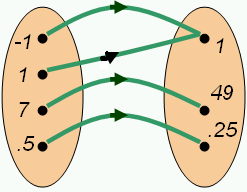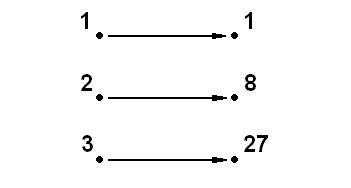Functions:Definition
Contents
Functions
A function is a relationship between two sets of numbers. We may think of this as a mapping; a function maps a number in one set to a number in another set. Notice that a function maps values to one and only one value. Two values in one set could map to one value, but one value must never map to two values: that would be a relation, not a function.

|
For example, if we write (define) a function as:
then we say:
- 'f of x equals x squared'
and we have
and so on.
This function f maps numbers to their squares.
Range and codomain
If D is a set, we can say
which forms a née of f is usually a subset of a larger set. This set is known as the codomain of a function. For example, with the function f(x)=cos x, the range of f is [-1,1], but the codomain is the set of real numbers.
Notations
When we have a function f, with domain D and range R, we write:
If we say that, for instance, x is mapped to x2, we also can add
Notice that we can have a function that maps a point (x,y) to a real number, or some other function of two variables -- we have a set of ordered pairs as the domain. Recall from set theory that this is defined by the Cartesian product - if we wish to represent a set of all real-valued ordered pairs we can take the Cartesian product of the real numbers with itself to obtain
- .
When we have a set of n-tuples as part of the domain, we say that the function is n-ary (for numbers n=1,2 we say unary, and binary respectively).
Other function notation
Functions can be written as above, but we can also write them in two other ways. One way is to use an arrow diagram to represent the mappings between each element. We write the elements from the domain on one side, and the elements from the range on the other, and we draw arrows to show that an element from the domain is mapped to the range.
For example, for the function f(x)=x3, the arrow diagram for the domain {1,2,3} would be:

Another way is to use set notation. If f(x)=y, we can write the function in terms of its mappings. This idea is best to show in an example.
Let us take the domain D={1,2,3}, and f(x)=x2. Then, the range of f will be R={f(1),f(2),f(3)}={1,4,9}. Taking the Cartesian product of D and R we obtain F={(1,1),(2,4),(3,9)}.
So using set notation, a function can be expressed as the Cartesian product of its domain and range.
f(x)
This function is called f, and it takes a variable x. We substitute some value for x to get the second value, which is what the function maps x to.
Types of functions
Functions can either be one to one (injective), onto (surjective), or bijective.
INJECTIVE Functions are functions in which every element in the domain maps into a unique elements in the codomain.
SURJECTIVE Functions are functions in which every element in the codomain is mapped by an element in the domain.
'BIJECTIVE' Functions are functions that are both injective and surjective.
---onto functions a function f form A to B is onto ,
Resources
- Course Textbook, pages 129-140
- Definition of Functions, Mathematics LibreTexts
Licensing
Content obtained and/or adapted from:
- Functions and relations, Wikibooks: Discrete Mathematics under a CC BY-SA license









